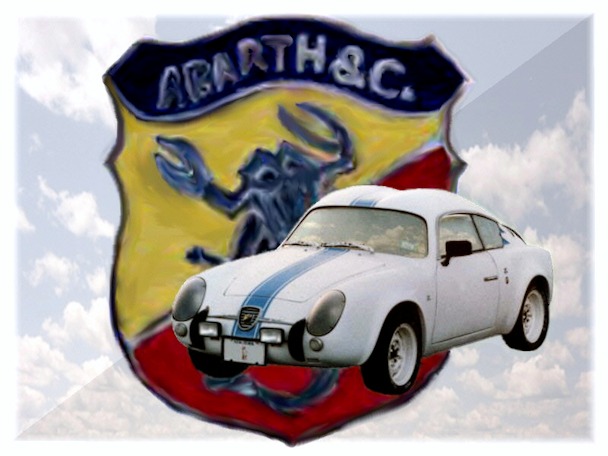

Dedicated to the Enjoyment and Preservation of Abarth automobiles.
The Fiat Abarth 750 GT Derivazione Coupe Zagato
aka "Double Bubble"

The first time I saw this car was in the spring of 1961 and the encounter marked the beginning of a 50+ year love affair with Abarth cars. Over the years, both this car and the likes of an Abarth OT-1000 Spider, a '59 Abarth Allemano Spider, a '59 Abarth modified 600, and a second 750 Abarth Zagato have each graced my premises. But today my first Abarth alone remains. The others are now fond memories of my automobile history.
Speaking of history, there seems to be a slight difference of opinion as to the exact name of this car, even among the factory folks at FIAT, Italy. Indeed, it was not named by FIAT at all. The automobile was officially named (and rightfully so, since he made it) by Carlo — actually Karl — Abarth (or at least by his secretary Regina, which is more likely the real story). The Abarth Works dubbed the model the Fiat Abarth 750 GT Derivizione Coupe Zagato.
Why Zagato? The Fiat Abarth 750 saw many variations. Originally the potent little Abarth 750 had the look of a Fiat 600 on steroids. But soon, specialty design houses like Boano, Allemano, Zagato, and others took the Abarth 750 and each put their own spin on the coach work. Even within the Zagato ranks there were several versions like the Record Monza and the Sestriere, neither of which had the "double bubble" roofline. The one that I am fortunate enough to own is the Abarth Zagato 750 Derivizione, otherwise known as the " Double Bubble". (The others are less noteworthy ONLY because I don't happen to own one! -- ooops, did I say that?)
The phrase "Double Bubble" was never an official name for the car, and likely did not originate at the Abarth Works. The Fiat Abarth 750 GT Derivizione Coupe Zagato was the version Karl Abarth chose to put into production. Elio Zagato's trademark was the double hump roof line. There is still much speculation as to why the bumps were put there. One theory is that the roof was heightened at each side to increase the passenger headroom. Another was that the roof line was lowered in the center to reduce the frontal area of the car and in turn create less wind resistance at speed. My theory is that Elio just liked the look. We may never know the real story.
I believe the name "Double Bubble" was actually coined here in the U.S. after Frank Roosevelt Jr. imported them for U.S. consumption shortly after production began. So "Double Bubble" (or "DB") is simply a nickname. But the name sort of stuck.
50 years later, many of these cars are still being driven and carefully maintained by collectors who appreciate the design, history, and performance of these truly remarkable works of Italian automotive art.
As you'll soon see, this particular car has seen a few appropriate modifications over the years. True to the Abarth tradition and to Karl Abarths philosophy, this car was made stronger and faster using the best technology available at the time. This car is still all Abarth, but now a Scorpion on Steroids!
Here's a short video clip done by our local TV station for a news spot they called "My Cool Car". It was made several years ago. How time goes by. Enjoy.
